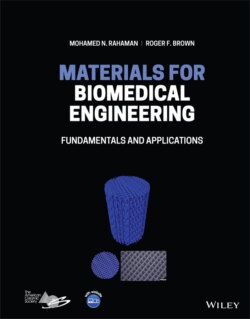Читать книгу Materials for Biomedical Engineering - Mohamed N. Rahaman - Страница 184
5.5.3 Effect of Surface Topography on Cell and Tissue Response
ОглавлениеAlthough the mechanism of interaction is complex, beneficial effects of nanoscale to microscale surface topography on the response of cells in vitro and in vivo have been reported for several biomaterials, as discussed in Chapter 21. These effects have been well demonstrated for Ti and its alloy Ti6Al4V. Titanium and Ti6Al4V see considerable use as implants in dental and orthopedic surgery, and their microtopography can be varied using common surface treatments such as machining, grit blasting, and acid etching. When compared to smoother machined surfaces (Ra ≈ 0.2 μm), microrough grit‐blasted surfaces of Ti6Al4V (Ra ≈ 3 μm) showed a better ability to stimulate the differentiation of osteoblastic cells in vitro (Schwartz et al. 2008). Additionally, when implanted in the vertebrae of sheep in vivo, implants with the microrough surface showed better bone formation around the implants and integration with host bone when compared to implants with the smoother machined surface.
The addition of microtopography, as noted earlier, is now a key design feature to improve outcomes associated with nondegradable biomaterials used as implants in medical and dental surgery. Adding nanoscale surface features to smooth (machined) surfaces using surface modification techniques has been reported to enhance the beneficial effects observed for microrough surfaces. For example, the formation of vertical TiO2 nanotubes (outer and inner diameter ~100 and ~80 nm, respectively, and height ~250 nm) on commercial purity Ti surfaces, has been shown to improve bone formation around the implants and integration with host bone in rabbit tibiae in vivo when compared to machined titanium surfaces (Bjursten et al. 2010).
For the same material, different treatments such as grinding, polishing, and grit blasting can lead to changes in other surface characteristics, such as surface chemistry, surface energy, contact angle and wettability, and not just in the surface topography. Consequently, the effects of surface topography alone often cannot be separated statistically from the contributions of these other surface properties and characteristics. This creates an additional level of complexity in understanding the mechanism by which surface topography influences the response of cells and in designing the optimal surface topography for a specific application.
